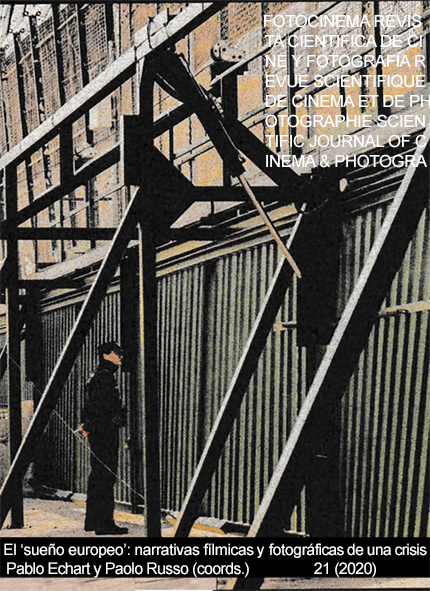Music and documentary films. A dialogue between Errol Morris and Philip Glass: The Thin Blue Line (1988)
DOI:
https://doi.org/10.24310/Fotocinema.2020.vi21.10013Keywords:
Music and Documentary Films, Reenactments, Minimalism, InterdisciplinarityAbstract
The Thin Blue Line is one of the key works on Errol Morris’ filmography. This documentary achieved the uncover of Randall Adams’ innocence, who had been charged of police officer murder in 1976. Nevertheless, studies on this film hasn’t focused yet on its music, composed by Philip Glass: it plays a major role as a constructor of Adams’ innocence, as well as it takes part in revealing corruption of U.S. justice. Reenactments used by Errol Morris and music by Glass dialogue along the documentary, in an ironical way as well as through repetition. Starting from documentary film essays as those published by Bill Nichols (2013, 2016) or Jonathan Kahana (2016), and those concerning musicology as well as music in documentary film like Holly Rogers (2016) or Tristan Evans (2015), this article aims to stablish bounds between Morris and Glass’ creative methods: through a dialogue between reenactments and musical minimalism’s hypothesis they achieve to prove Randall Adams’ innocence.
Downloads
Metrics
Publication Facts
Reviewer profiles N/A
Author statements
Indexed in
-
—
- Academic society
- N/A
- Publisher
- Universidad de Málaga
References
Bates, P., y Morris, E. (2016). Truth not guaranteed. An Interview with Errol Morris (1989). En J. Kahana (Ed.), The documentary film reader: history, theory, criticism (pp. 807-809). New York: Oxford University Press.
Brooke, M. (2014). Endings...: The Thin Blue Line. Sight & Sound, XXIV(9), 128.
Curry, R. (1995). Errol Morris’ Construction of Innocence in The Thin Blue Line. Rocky Mountain Review of Language and Literature, 49(2), 153-167.
Evans, T. (2015). Shared Meanings in the Film Music of Philip Glass: Music, Multimedia and Postminimalism. Farnham: Ashgate.
Fallon, K. (2012). Several sides of Errol Morris. Film Quarterly, LXV(4), 48-53.
Glass, P. (s. f.). LOOKING - from «The Thin Blue Line». (B. Pittman, Ed.). Recuperado de https://musescore.com/user/10536501/scores/5500385
Glass, P. (1989). Solo Piano [Disco]. CBS.
Glass, P. (2003). Music From The Thin Blue Line [Disco]. Orange Mountain Music.
Glass, P. (2006). The Piano Collection. London: Wise Publications.
Glass, P. (2015). Palabras sin música. (M. López, Trad.). Barcelona: Malpaso.
Kahana, J. (2016). Introduction to Section VI. En J. Kahana (Ed.), The documentary film reader: history, theory, criticism (pp. 723-725). New York: Oxford University Press.
Mertens, W. (1983). American Minimal Music. La Monte Young, Terry Riley, Steve Reich, Philip Glass. (J. Hautekiet, Trad.). London: Kahn & Averill.
Millard, K. (2014). 14 Lessons on Screenwriting from Errol Morris. En Screenwriting in a Digital Era (pp. 63-76). New York: Palgrave Macmillan.
Nichols, B. (2008). Reenactment and the Fantasmatic Subject. Critical Inquiry, 35(1), 72-89.
Nichols, B. (2013). Introducción al documental. (M. B. García, Trad.). Coyoacán: Universidad Nacional Autónoma de México.
Nichols, B. (2016). Speaking truth with film: evidence, ethics, politics in documentary. Oakland: University of California Press.
Plantinga, C. (2009). The Philosophy of Errol Morris. Ten Lessons. En W. Rothman (Ed.), Three documentary filmmakers: Errol Morris, Ross McElwee, Jean Rouch (pp. 43-59). Albany: State University of New York Press.
Resha, D. (2015). The Thin Blue Line. En The Cinema of Errol Morris (pp. 49-81). Middletown: Wesleyan University Press.
Rogers, H. (2015). Introduction. Music, Sound and the Nonfiction Aesthetic. En H. Rogers (Ed.), Music and Sound in Documentary Film (pp. 1-19). New York: Routledge.
Suárez García, J. I. (2012). El embellecimiento retórico en el Officium Defunctorum de Tomás de Victoria. Revista de Musicología, XXXV(1), 263-294.
Tugce Kaymaz, Ö. (2012). The Thin Blue Line: How can we destroy actuality with editing? Cinej Cinema Journal, 1(2), 73-78.
Downloads
Published
How to Cite
Issue
Section
License
All contents published in Fotocinema Revista científica de cine y fotografía are protected under the Creative Commons Attribution-NonCommercial-ShareAlike 4.0 International (CC BY-NC-SA 4.0) license. All about this license is available in the following link: <http://creativecommons.org/licenses/by-nc-sa/4.0>
Users can copy, use, redistribute, share and exhibit publicly as long as:
- The original source and authorship of the material are cited (Journal, Publisher and URL of the work).
- It is not used for comercial purposes.
- The existence of the license and its especifications are mentioned.
There are two sets of authors’ rights: moral and property rights. Moral rights are perpetual prerogatives, unrenounceable, not-transferable, unalienable, imprescriptible and inembargable. According to authors’ rights legislation, Fotocinema. Revista científica de cine y fotografía recognizes and respects authors moral rights, as well as the ownership of property rights, which will be transferred to University of Malaga in open access. The property rights are referred to the benefits that are gained by the use or the dissemination of works. Fotocinema. Revista científica de cine y fotografía is published in an open access form and it is exclusively licenced by any means for doing or authorising distribution, dissemination, reproduction, , adaptation, translation or arrangement of works.
Authors are responsable for obtaining the necessary permission to use copyrighted images.














13.png)



